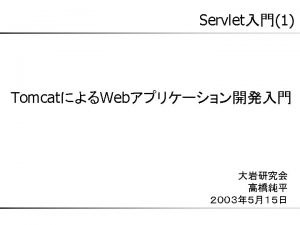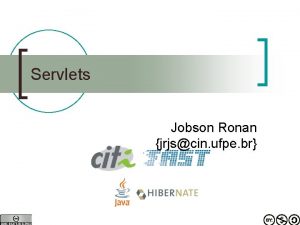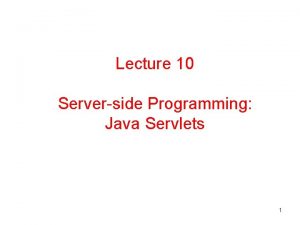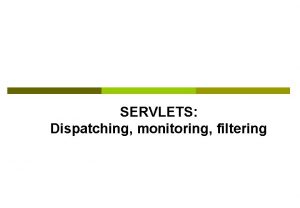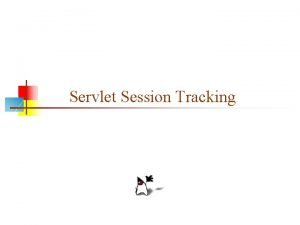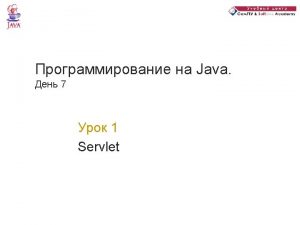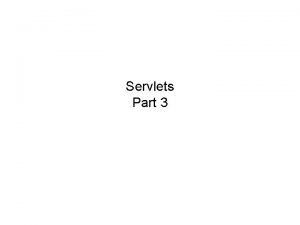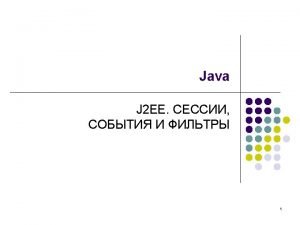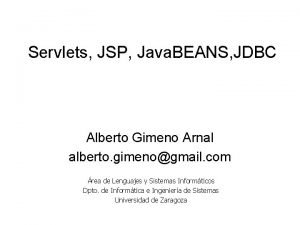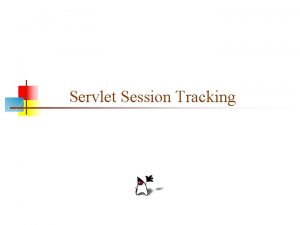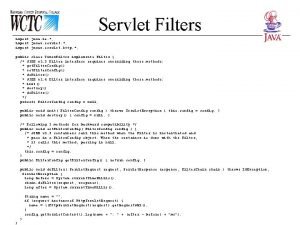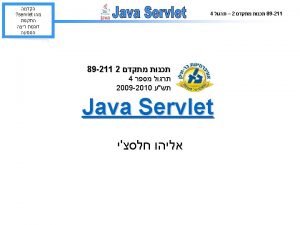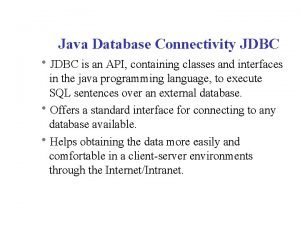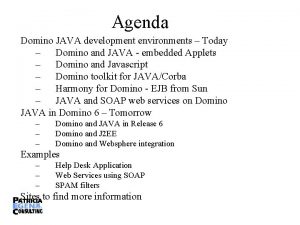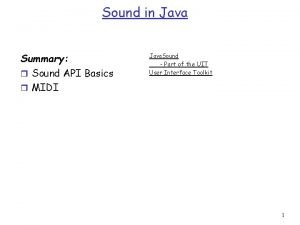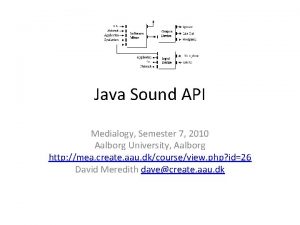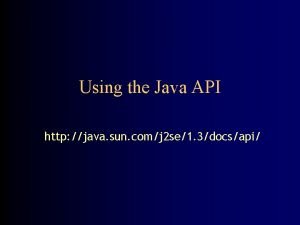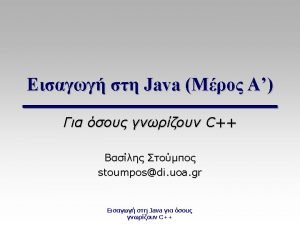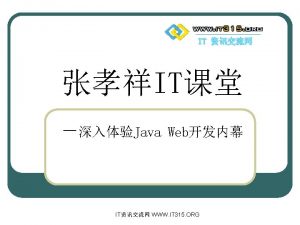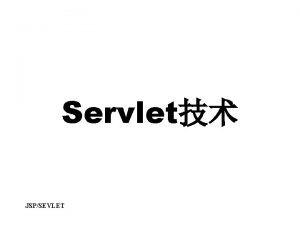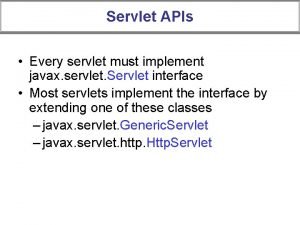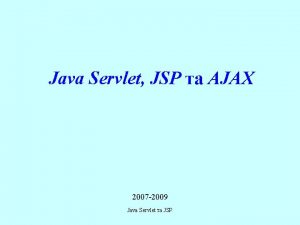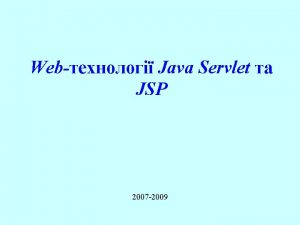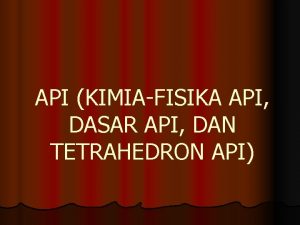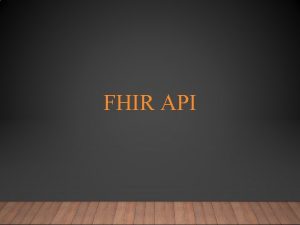The Java Servlet API HTTP Hyper Text Transfer




































- Slides: 36

The Java Servlet API

HTTP �Hyper. Text Transfer Protocol �Stateless request/response client-server protocol �Requests: �Method: GET, POST, HEAD, TRACE, OPTIONS, PUT, DELETE

HTTP �Requests, continued �URI (required in HTTP/1. 1) �Header Fields � E. g. how the response should be returned, under what conditions, identification and characterization of client, accounting data �Body � POST data � Empty for GET

HTTP �Response: �Status code (machine), reason (human) �Header � Metadata, e. g. Content-Type (Media type), Content-Length, Last-Modified, Etag �Body � (X)HTML, other XML, text, binary data …

URL Connections �java. net also -- connections extend Socket �Encapsulates HTTP and FTP connections �URI, URLConnection, Http. URLConnection

Servlets Definition �Server side component in a client server model (now the browser is the client ) �Reside in a servlet container, assigned to a certain URL pattern. �Provide mechanisms for maintaining state over the stateless HTTP protocol

Servlet Model

Servlet API �Interfaces: �Http. Servlet. Request �Http. Servlet. Response �Http. Session �Http. Binding. Session �Http. Session. Context �Interfaces are implemented by server providers and can be used out of the box

Servlet API �Classes �Cookie �Http. Servlet �Http. Session. Binding. Event �Http. Utils

Servlet Lifecycle

Servlet Lifecycle �Multithreaded access (usually default) �init called first time only (by the container) �zero to many calls to service �destroy called

init (Servlet. Config) �call super. init (config), or just use init () �Called once �Prior to any call to service �Don’t worry about multithreading issues here �Sometimes used to get resources needed for the lifetime of the servlet

service (req, resp) �Not usually overridden �Default impl. determines what request handler to call (based on HTTP request type), calls it �Service method will call do. Get, do. Post, do. Put, etc. based on service type. �Default implementations provided for do. Head, do. Trace, do. Options

do. Post, do. Get, etc. �do. Post (Http. Servlet. Request req, Http. Servlet. Response resp) � Implement this to handle POSTs � Read from req, build resp �Multithreaded access by default (depending on server config) � Beware instance variables, shared data � config and context are shared, session is usually safe, req/resp are not � Use locks and/or synchronized data structures if shared data is an issue

destroy () �called once �Servlet timeout, servlet reload, container shutdown �Other threads may still be processing service requests, no further requests will be processed �Release resources, write data, etc.

Servlet Skeleton import javax. servlet. * import javax. servlet. http. * import java. io. * public class my. Servlet extends Http. Servlet { void do. Get (Http. Servlet. Request request, Http. Servlet. Response response) throws Servlet. Exception, IOException { response. set. Content. Type (“text/html”); Print. Writer out =response. get. Writer(); . . out. close() } }

Using servlets Generating output, handling form data, maintaining state

Servlet API Main Roles �Servlet Class for handling client request �Http. Servlet. Request for getting all the information that the client passed �Http. Servlet. Response for sending a response to the client �Cookie/Session for storing and reading session variables

Review �Typically used in HTTP servers �Server side of HTTP request/response �Interpret request, generate response �Servlets are container-managed �Respond to events, do. XXXX �Need to consider lifecycle, threading policies, security, resource access and configuration

Generating (X)HTML �Set content type �Access response output stream �As a Print. Writer, via response. get. Writer () �Use out. println, out. print �Escape quotes �You are responsible for all content, including doctype header (and xml declaration if using XHTML)


HTML Forms �Form data consists of name, value pairs �Values are retrieved on the server by name �GET passes data in the query string �Always URL-encoded �POST passes data in content of request �Either URL-encoded, or multipart/form-data

Structure of forms �form element �Attributes: (REQUIRED) � method (GET) � enctype, accept-charset � onsubmit, onreset � action

Forms contain controls �input : many kinds of form data � Text fields, checkboxes, radio buttons, passwords, buttons, hidden controls, file selectors, object controls �button : type=submit|button|reset �select : a menu, contains option child elements �textarea : multi-line text input field �Other html tags can be present (e. g. format forms in tables)

Servlet support �Does decoding for you, common interface �Just use request. get. Parameter (String name) for both GET and POST �Returns null if parameter doesn’t exist �Multipart not well supported in standard API �Use request. get. Reader (), request. get. Input. Stream (). . parse yourself �Use 3 rd party API, e. g. com. oreilly. servlet. multipart. Multipart. Parser, org. apache. commons. fileupload. servlet

More Servlet Support �Retrieve all values matching name: � request. get. Parameter. Values (String name) � Returns String array, or null �Retrieve all parameter names: � request. get. Parameter. Names () � Returns String Enumeration �Retrieve an immutable Map<String, String> of name, value pairs � request. get. Parameter. Map ()

Maintaining State �Cookies � Name, value pairs with properties � Lifetime independent of request/response � Passed between client and server during HTTP transactions �Hidden fields, URL rewriting � Form controls (input type=“hidden”) added dynamically to pages, containing name/value that should be associated with client. � Hardcoded links (href) contain name/value data in query

Maintaining State, continued �Sessions �Pass a single cookie (or fallback to URL rewriting) containing a session ID �Server maintains a mapping between session ID and associated data stored on the server

Cookie Support �Cookie class �Name, value �Domain, path �max. Age �> 0 Persist cookie, in seconds � -1 (default) in memory, until browser is closed � 0 delete cookie on client

Using Cookies �Retrieving cookies � request. get. Cookies () returns array of Cookie or null �Creating cookies � Cookie (String name, String value) �Updating client � Existing Cookies can be modified, but must be added to response for change to take place � response. add. Cookie (Cookie c)

Sessions Support in Java �Http. Session is an interface �for a glorified (specialized) Map<String, Object> or similar �One-to-one mapping between jsession. ID and Http. Session �Attached to HTTPServlet. Request object in do. XXXX methods �request. get. Session (boolean create=true) �request. is. Requested. Session. Id. Valid ()

Sessions support �Associated with one client (usually) �Id, creation time, last accessed time �Can be invalidated manually or due to inactivity �Lifetime: new-->active-->invalid �Object get. Attribute (String name) �set. Attribute (String name, Object o) �Enumeration get. Attribute. Names ()

More Session details �Interface maps String to Object, you must cast ref to derived type �If your object uses generics (e. g. typed lists), you’ll get a compiler warning when casting �Interface is pre 1. 5, strips away type info �Any other code can take e. g. a List<String> session object and treat it as an untyped list �Solutions: be careful, store keys into external structures, use Checked wrappers on collections (runtime cost)

Servlet. Config �Provided to a servlet upon initialization by the web server (container) �Simple read only interface to configuration details � String get. Init. Parameter (String name) � Enumeration get. Init. Parameter. Names () � String get. Servlet. Name () �Can also access Servlet. Context

Servlet. Context �Lets a servlet communicate with its container �Access container-managed resources, dispatch requests, write to logs �Can be used as a global data store (like an application-wide session) �But is specific to single web container -- does not work in clustered scenarios �Recommendation is to use a resource that is shared (e. g. cached Data. Source, directory) �We will see/use the servlet context later on

Questions?
 Servlet mcq
Servlet mcq Java hyper text
Java hyper text Import javax.servlet.http.*
Import javax.servlet.http.* Servlet tutorial
Servlet tutorial Text to text text to self text to world
Text to text text to self text to world Hyper text html
Hyper text html Tomcat webapps folder
Tomcat webapps folder Servlet
Servlet Jsessionid
Jsessionid Java server pages
Java server pages Introduction of jsp
Introduction of jsp Servlet filter dispatcher
Servlet filter dispatcher Session tracking in servlet
Session tracking in servlet Dot status
Dot status Servlet chaining
Servlet chaining Servlet forward
Servlet forward Jsp jdbc
Jsp jdbc Server.servlet.session.persistent
Server.servlet.session.persistent Javax.servlet
Javax.servlet Servlet 4
Servlet 4 Cos'è una servlet
Cos'è una servlet Java database connectivity api
Java database connectivity api Lotus notes java api
Lotus notes java api Java summary
Java summary Java sound api
Java sound api Java printer api
Java printer api Java graphics
Java graphics Generic communication model
Generic communication model Sun java api
Sun java api Dynamic proxies in java
Dynamic proxies in java Java reflection api
Java reflection api A wave is a disturbance that transfers
A wave is a disturbance that transfers Http //mbs.meb.gov.tr/ http //www.alantercihleri.com
Http //mbs.meb.gov.tr/ http //www.alantercihleri.com Http //pelatihan tik.ung.ac.id
Http //pelatihan tik.ung.ac.id Http //www.phys.hawaii.edu/ teb/optics/java/slitdiffr/
Http //www.phys.hawaii.edu/ teb/optics/java/slitdiffr/ Http //www.phys.hawaii.edu/ teb/optics/java/slitdiffr/
Http //www.phys.hawaii.edu/ teb/optics/java/slitdiffr/ Http://java.sun.com
Http://java.sun.com


